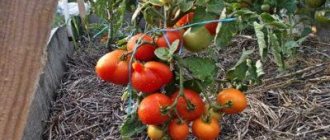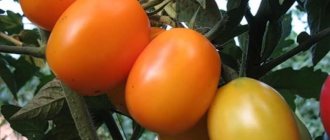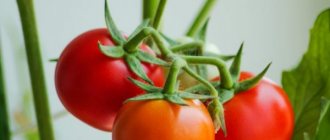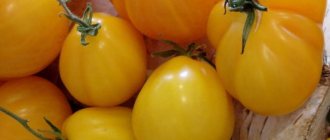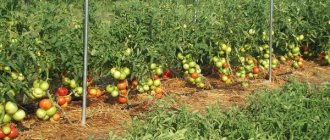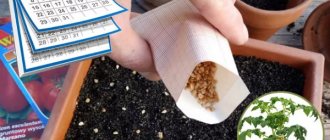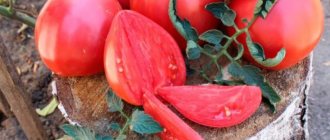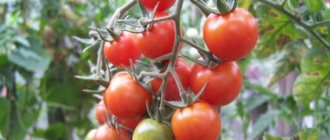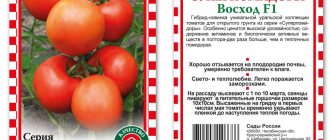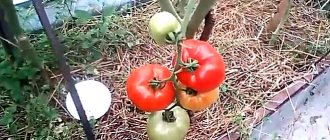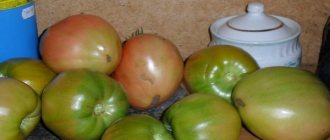Description of the variety
Fruit:
- Flat-rounded in shape, with slight ribbing;
- With smooth, smooth, glossy, dense skin;
- Unripe fruits have a green tint; when ripe, they acquire a rich pink-scarlet color;
- With juicy, sugary pulp;
- They have a pleasantly sweet taste, with a slight sourness;
- High sugar content;
- Seed chambers are small in size, with insignificant seeds;
- Medium size. The average weight varies from 120 to 200 grams.
Bushes:
- Determinate, standard plant;
- Reach a height of up to 70 cm.
The best and most productive varieties of tomatoes
For open ground, breeders also offer species with high yields of hybrid origin; they are resistant to diseases and temperature changes. The best tomato varieties of 2021:
- Intuition F1 is one of the best tomato hybrids for picking with trusses, mid-season, from germination to harvesting the first vegetables - 110 days.
- Katya F1 is an early ripening hybrid. The fruits weigh 90-130 g and ripen simultaneously. From 1 m² you can harvest more than 10 kg of fruit per season.
- Search F1 – unpretentious and at the same time tasty tomatoes. The hybrid withstands cold weather and is immune to most diseases. The bushes are strewn with small red fruits, which are excellent for pickling and canning.
- Blagovest F1 is an early-ripening hybrid. The fruits are round, glossy, with slightly pronounced ribbing. From one bush you can collect up to 5 kg of fruit.
- La la fa F1 - has excellent consumer qualities, high yield and unpretentiousness. The average weight of the fruit is 140-170 g. From 1 m² you can harvest up to 20 kg.
- Vladimir F1 - has a high yield and is suitable for cultivation in any type of soil. High productivity throughout the entire fruiting period.
- Beef King F1 is an early maturing Dutch hybrid. The tomatoes are round, dense, smooth. From one bush you can collect up to 4-5 kg. Resistant to low temperatures and diseases.
- Ashdod F1 – tomatoes with smooth, dense skin. Fruit weight is from 110 to 140 g. The pulp has a bright burgundy color.
- Tanya F1 is a hybrid from the Netherlands with excellent immunity, dense structure, and good yield. The fruits have a regular round shape, weighing 150-200 g. They tolerate transportation well.
Attention!
If the designation on a bag of planting material is F1 – hybrids of tomatoes (or other plants) of the first generation, F2 – of the second, and so on.
Exceptional taste, fruit weight, constant yield, disease resistance, adaptation to weather conditions are the advantages of hybrids over tomato varieties.
The new tomato variety “Rosy Cheeks” has gained recognition among many gardeners in a short period of time. The tomato will be appreciated by lovers of fleshy and dense tomatoes. However, in order to get fleshy tomatoes, the vegetable grower must know all the features of the “Rosy Cheeks” variety.
In 2002, seed scientists developed a new tomato variety, “Rosy Cheeks.” Official registration in the State Register of Russia - 2003.
Fruit:
- Large size;
- They have a flat-round shape;
- When ripe, it is raspberry-pink in color. Unripe tomatoes are green in color with a dark spot near the stalk;
- The cluster contains from three to five fruits;
- With dense fleshy pulp;
- A large number of cameras;
- Average dry matter content;
- The average weight varies from 200 to 350 grams.
Bushes:
- Determinate, non-standard plant, reaches 70-90 cm in height;
- Light green leaves, medium in size, with small lobes;
- The formation of the first inflorescence occurs over 6-8 leaves, subsequent ones - after one or two leaves. However, it is possible to arrange them directly next to each other.
The tomato variety “Rosy Cheeks” has a number of advantages:
- Large fruits and at the same time rapid ripening;
- Excellent product and taste characteristics of the fruit;
- Excellent keeping quality;
- High yield;
REFERENCE: When grown in greenhouse conditions, it grows up to one and a half meters.
- Possibility of transporting fruits;
- The versatility of fruit use;
- Immunity to diseases.
The “Rosy Cheeks” variety has no significant disadvantages.
Application of fruits
Tomatoes are incredibly tasty fresh. However, the versatility of use allows the fruits to be used for preservation and for the production of tomato paste. Suitable containers for pickling are buckets, barrels or pans, since large fruits will not fit in jars.
The process of growing tomatoes is simple; they are characterized by rapid formation of ovaries and ripening, and do not require the daily attention of the vegetable grower.
Basic recommendations for preparing seed material:
- It is advisable to purchase seed material in specialized stores. Give preference to companies that have a proven reputation and their own breeding base;
- Self-collected seeds need to be treated in a manganese solution. Then they are washed in clean water and sprinkled with earth. If these conditions are met, the plant will harden and the occurrence of most diseases can be prevented in the future.
Basic rules for sowing seeds:
- Seed material is sown for seedlings from March 1 to March 10;
- For this purpose, you will need pots that are filled with a nutrient mixture. The dimensions of the landing container are 10x10;
- Before direct planting in open ground, seedlings grow in pots for 55-60 days;
- During this time, two or three feedings are carried out using complex fertilizers;
- After one or two full-fledged leaves appear on the sprouts, the seedlings dive.
How to plant seedlings correctly:
- Seedlings are planted in open ground in mid-May;
- 10 days before the expected planting, they begin to harden the seedlings;
- For planting, give preference to sunny areas that are reliably sheltered from cold winds;
- It is preferable to plant seedlings in loamy soil;
REFERENCE: To obtain an earlier harvest, seedlings are planted in open ground in early May and covered with a transparent film until warm weather sets in.
- The row spacing and interval between tomato bushes should be 50 centimeters.
To get a bountiful tomato harvest, you need to correctly form the bush and carefully tie it to a support. It is also necessary to follow basic recommendations for further care:
- The recommended planting pattern for seedlings is 50x50 cm. To avoid crowding, no more than 4-5 seedlings per 1 m2;
- Form a bush into one or two stems;
- Water and feed plants in a timely manner. Use warm water for watering. Feed three times per season. If there is an abundant growth of greenery and there is no flowering, the tomatoes are fed with a phosphorus-potassium mixture;
- They take care of their stepsons;
- Loosen the soil after the watering procedure;
- Although the tomato variety is heat-loving, during extreme heat, tomatoes may lack ovaries, and sometimes even shed existing ones. In this case, a solution of boric acid is used, this not only promotes rapid ovary development, but also prevents the occurrence of late blight. Spray the leaves and flowers with a prepared solution at a ratio of 20 grams of boric acid per 20 liters of water. Before mixing, the acid is first dissolved in a cup filled with hot water. The resulting mixture is poured into a bucket and mixed thoroughly.
We invite you to familiarize yourself with the canopy with railings for the porch
Diseases and pests
The tomato variety “Rosy Cheeks” is not susceptible to the following diseases:
- Fusarium;
- Alternaria;
- Verticillium wilt;
- Phytophthora, since it manages to ripen before its active development begins in the beds.
Productivity
The “Rosy Cheeks” tomato has a high and stable yield. The yield from 1 m2 of bed is 5.5 kilograms of tomatoes.
The “Rosy Cheeks” variety is recommended for cultivation in the following regions of Russia:
- Severny;
- North-West;
- Central;
- Volgo-Vyatka;
- Central Black Earth;
- Srednevolzhsky;
- North Caucasus.
According to reviews of some gardeners, the “Rosy Cheeks” variety will be an excellent replacement for related varieties: “Lyan” and “Volgogradskoye”.
Tomatoes are perfect for gardeners who like to experiment and are looking for new, disease-resistant varieties. Due to the large size, excellent taste characteristics of the fruit, excellent keeping quality and transportability, they will be an ideal option for farmers who grow tomatoes for sale.
Experienced gardeners confirm the consistently high yield of the “Rosy Cheeks” variety. The main requirements for this are to ensure proper care, timely watering and loosening of the soil. The “Rosy Cheeks” tomato can be grown both for personal consumption and for sale.
We recommend articles on the topic
The unusual tomato variety "Geisha" will undoubtedly interest gardeners who like to add variety to their garden plot with a new crop. The compact, strong plant and excellent taste characteristics of the fruit will not leave anyone indifferent. Pink-scarlet fruits with juicy, sugary pulp are ideal for preparing a variety of dishes.
The tomato variety "Geisha" was obtained as a result of the work of Russian breeders.
Fruit:
- Flat-rounded in shape, with slight ribbing;
- With smooth, smooth, glossy, dense skin;
- Unripe fruits have a green tint; when ripe, they acquire a rich pink-scarlet color;
- With juicy, sugary pulp;
- They have a pleasantly sweet taste, with a slight sourness;
- High sugar content;
- Seed chambers are small in size, with insignificant seeds;
- Medium size. The average weight varies from 120 to 200 grams.
Bushes:
- Determinate, standard plant;
- Reach a height of up to 70 cm.
When choosing tomatoes for their plot, gardeners, first of all, rely on varietal or hybrid characteristics. Productivity is the most important criterion on which the quantity and quality of the harvest depends. Sometimes it can be difficult to choose the right option from the rich variety of tomatoes for open ground and greenhouses. Then varieties are selected depending on the growing region, ripening period, degree of disease resistance and other factors.
For open ground, breeders also offer species with high yields of hybrid origin; they are resistant to diseases and temperature changes. The best tomato varieties of 2020:
- Intuition F1 is one of the best tomato hybrids for picking with trusses, mid-season, from germination to harvesting the first vegetables - 110 days.
- Katya F1 is an early ripening hybrid. The fruits weigh 90-130 g and ripen simultaneously. From 1 m² you can harvest more than 10 kg of fruit per season.
- Search F1 – unpretentious and at the same time tasty tomatoes. The hybrid withstands cold weather and is immune to most diseases. The bushes are strewn with small red fruits, which are excellent for pickling and canning.
- Blagovest F1 is an early-ripening hybrid. The fruits are round, glossy, with slightly pronounced ribbing. From one bush you can collect up to 5 kg of fruit.
- La la fa F1 - has excellent consumer qualities, high yield and unpretentiousness. The average weight of the fruit is 140-170 g. From 1 m² you can harvest up to 20 kg.
- Vladimir F1 - has a high yield and is suitable for cultivation in any type of soil. High productivity throughout the entire fruiting period.
- Beef King F1 is an early maturing Dutch hybrid. The tomatoes are round, dense, smooth. From one bush you can collect up to 4-5 kg. Resistant to low temperatures and diseases.
- Ashdod F1 – tomatoes with smooth, dense skin. Fruit weight is from 110 to 140 g. The pulp has a bright burgundy color.
- Tanya F1 is a hybrid from the Netherlands with excellent immunity, dense structure, and good yield. The fruits have a regular round shape, weighing 150-200 g. They tolerate transportation well.
Tomatoes: advantages and disadvantages
The tomato variety "Geisha" has a number of positive advantages, namely:
- Good yield;
- Excellent taste characteristics of the fruit;
- No need to tie up bushes due to compactness;
- Immunity to late blight and fusarium;
- Fruit resistance to cracking;
- Long period of fruiting throughout the season;
- Good keeping quality;
- Resistant to adverse factors and weather conditions.
No significant deficiencies were identified in the Geisha tomato. Characteristic features include the variety’s demands on heat and fertilizing; growing on poor soils significantly reduces yields.
10 kg of tomatoes from each bush. How to achieve such success, advice from an experienced gardener:
Tomato variety Lazy Miracle
Description. Early ripening determinate variety. Does not require tying, pinching or shaping. Tomatoes form dense clusters. Thanks to early fruiting, the crop can be harvested twice per season. The fruit is red, elongated, smooth, with dense pulp. The variety is resistant to late blight and other major diseases, as well as cold weather. The Lazy Miracle tomato tolerates long-term transportation well.
| Purpose | Growing | Ripening time (days) | Fruit weight (g) | Productivity per sq.m (kg) |
| 85-95 | 60-65 | 6-8 |
Growing tomatoes
The "Geisha" variety is grown through seedlings.
How to prepare seeds?
Proper preparation of seed material:
- Planting material must be disinfected using a weak solution of manganese. The seed material is placed in the solution for 30 minutes. Then rinse in clean water;
- Then the seeds are soaked in a growth stimulator for 10-12 hours.
Sowing seed material
Recommendations for proper sowing of seeds for seedlings:
- Start sowing seed material for seedlings in March;
- Since the tomato crop places increased demands on the soil composition, it is recommended to use a mixture of garden or turf soil with the addition of humus. The presence of superphosphate and sifted wood ash is also required. You can use purchased soil mixture;
- Sow in containers or small peat pots. Containers with sown seeds are covered with film and left in a warm room;
- As soon as the first shoots appear, the film is removed and the temperature in the room is lowered. Containers with seedlings are placed in a well-lit place;
- Throughout their growth, seedlings need moderate watering with warm, soft water;
- If sowing was carried out in separate pots, no picking is carried out; the seedlings are simply transplanted into the ground directly in the pots. When sowing seed material into a common container, as soon as two true leaves are formed, begin picking;
- Afterwards, the young shoots are fed using a complete complex fertilizer. The second feeding is carried out after 14 days;
- A week before the planned date of planting in a permanent place, the seedlings begin to be hardened off in order to speed up the adaptation period in the new place.
Rules for planting seedlings
How to plant seedlings correctly:
- Planting into a greenhouse structure is carried out in early May;
Young seedlings are planted in unprotected soil in late May, in well-warmed soil.
- Before planting, carefully loosen the soil and spill it with a warm manganese solution;
- Planting holes are placed at intervals of 50 cm from each other, the depth of the holes should be at least 30 cm. The width between the rows should be at least 70 cm;
- The space between the tomato bushes is mulched to protect the plantings from pests and weeds. Humus or straw is used as mulch.
Tomato variety Raspberry giant
Description. Just like Ox's Heart, it refers to large varieties of tomatoes. Early, but sometimes manifests itself as mid-early. The plant is determinate, requires staking, but does not need pinching. The fruits are large, when ripe they are distinguished by a rich crimson color, and have slight ribbing in the stalk area.
| Purpose | Growing | Ripening time (days) | Fruit weight (g) | Productivity per sq.m (kg) |
| 90-110 | 200-400 (600) | 6-10 (12) |
Bush care
Further planting care includes:
- Watering. Water sparingly, using only warm water. Cold water when watering causes the ovaries to drop;
- Loosening. After the loosening procedure, the soil will be enriched with oxygen, which will have a positive effect on the root system. Loosening begins immediately after watering, this will prevent the formation of an earthen crust;
- Formation. The bush is formed into two or three stems;
- During the season, three or four feedings using liquid complex fertilizers.
ATTENTION: The use of organic fertilizers is allowed, but they should not be abused.
Tomato variety Siberian early ripening
Description. Early ripening determinate type, requires garter. The fruits are medium-sized and large, red, slightly ribbed. The Siberian early-ripening tomato variety is frost-resistant, has high resistance to blackleg and moderate resistance to brown spot.
| Purpose | Growing | Ripening time (days) | Fruit weight (g) | Productivity per sq.m (kg) |
| 110-120 | 60-110 | 8-10 |
Diseases and pests
Despite the fact that the Geisha tomato variety has good immunity against major diseases, preventive measures should not be neglected:
- Before planting, the soil is treated with a disinfecting manganese solution or copper sulfate solution;
- Young seedlings are periodically sprayed with “Fitosporin” or other non-toxic drugs that have an antifungal effect;
- Regularly ventilate the greenhouse structure to prevent the occurrence of gray rot;
- You can avoid the appearance of insect pests if you promptly destroy weeds and remove the lower leaves on the bushes. Pests that are found are collected by hand and then burned. Afterwards, the bushes are sprayed with an aqueous solution of ammonia or celandine;
- The use of the drug “Bravo” is effective against Phoma.
Tomato variety Auria
Description. Mid-season indeterminate plant, requires pinching. The fruits are large, fleshy, elongated, often with a forked end. Color – red. The Auria tomato variety is drought and disease resistant. The fruits do not crack and tolerate transportation well.
We invite you to familiarize yourself with Giant tomatoes
| Purpose | Growing | Ripening time (days) | Fruit weight (g) | Productivity per sq.m (kg) |
| 100-110 | 150-180 | 7-12 |
Productivity
On average, the yield of the “Geisha” variety per 1 m2 varies from 7 to 8 kg of tasty tomatoes. The harvest from each bush is up to 4 kg.
Which regions are best to grow in?
The tomato variety "Geisha" is recommended for cultivation in all regions of the Russian Federation, however, the highest yield was recorded when grown in the middle zone. Tomato can be grown under film covers, in greenhouse structures and unprotected soil.
You can also plant them in containers and flowerpots to later place them on a loggia or glassed-in veranda.
Tomato variety Bull's heart
Description. Mid-season determinate variety, requires staking to a support. The fruits are large, fleshy, heart-shaped, and can be of different colors - from pink or red to white-yellow (depending on the hybrid form). On the upper tiers of the bush, the tomatoes are much smaller than on the lower ones. The fruits are characterized by good keeping quality and transportability. With proper agricultural technology, the Bull's Heart tomato variety is highly resistant to diseases and pests.
| Purpose | Growing | Ripening time (days) | Fruit weight (g) | Productivity per sq.m (kg) |
| 120-130 | 300-500 (1000) | 7-10 |
Reviews about the variety from those who planted
The tomato with the unusual name “Geisha” appealed to most gardeners. Summer residents celebrate the friendly ripening of beautiful, neat tomatoes. The tomato has gained popularity due to its unpretentiousness and endurance.
It’s worth trying to plant a Geisha tomato in your garden. It is distinguished by its productivity, undemandingness, and the ability to grow both in greenhouses and in open ground. This is the best option for beginning gardeners, since the growing process will not cause any particular trouble. Also, if you wish, you can collect seed material yourself, plant it after 2-3 years and get a good tomato harvest.
Varieties for open ground
A huge number of species with excellent yields are intended for growing vegetables in the open air. Low-growing bushes with large fruits are one of the advantages of tomatoes for the soil. Such heat-loving plants are easier to care for and do not require complex agricultural practices.
According to ripening period
Tomatoes, like other vegetable crops, are characterized by different ripening periods, from early to late.
The ripening time, color and shape of tomatoes depends on the variety.
Usually early-ripening vegetables with not large fruits and not a large harvest, but with a quick, friendly yield of ripe tomatoes. Mid-season ones also have medium sizes. Late ones are usually difficult to care for, but it is among them that you can find champions in weight, but there are not many such beauties on the bush.
We invite you to familiarize yourself with Mazai cucumbers description
Every year, breeders create new species with high quality indicators. In stores you can buy specialized varieties of tomatoes designed for growing in certain climatic conditions. Classification by regions of Russia:
- for the Moscow region: Champion, Sweet Bunch, Honey, Pink Elephant, Fireworks, Bull's forehead;
- for the southern regions: Torch, Novice, Titan, Winner, Bison, Ermak, Gift, Mikado;
- for the middle zone: Bull's Heart, Black Prince, Uzbek (Yusupov), Moskvichka, Snowdrop, Big Brother, Spasskaya Tower;
- for Siberia: Siberian heavyweight, Ultra early ripening, Sanka, Abakan pink;
- for the Urals: Coin, Bull's Heart, Button, Countryman, Yellow Buyan, Bullfinch, Demidov;
- for the far north: Snowy Tale, Ballerina, Ladyfingers, Berdsky Large, Countryman, Oak, Gina.
An unpredictable, cold or, conversely, excessively warm climate is not a reason to refuse to grow tomatoes in open ground. Thanks to selection, varieties have been developed that grow and develop well in any terrain.
To obtain a rich harvest, you need to choose tomato varieties not only with the appropriate characteristics. It is necessary that this criterion be supplemented by such an indicator as disease resistance.
Late blight, root rot, tobacco mosaic, cladosporiosis are diseases that most often affect plantings of heat-loving crops.
A catalog of tomatoes that can withstand the onslaught of various diseases:
- Blitz;
- Koenigsberg;
- Geisha;
- Betta,
- Anyuta;
- Bohemia;
- Chio-chio-san;
- Tatiana;
- Puzata hut;
- Lights of Moscow;
- Yablonka Russia;
- Crimson giant.
Unfortunately, there are no varieties that are 100% resistant to infections. But there are hybrids that produce a harvest until the active phase of many fungal diseases and infections begins.
According to ripening period
| Ripening period | Ripening of fruits after the appearance of the first shoots | general characteristics | The most productive tomatoes (2020) |
| Ultra-early ripening | On day 80-85 | The fruits are small, juicy, and low in sugar. The height of the bush is no more than 50 cm. Not suitable for preservation. | Little Red Riding Hood, Pride of Russia, Benito, Superstar, Valentina, Marisha, Maksimka |
| Early ripening | For 90-95 days | Small, delicate fruits, average yield. Suitable for canning and salads. Bushes grow up to 70 cm | Agatha, Riddle, Augustine, Lyana, Sanka, Buyan, Lakomka, Amur standard, Grandmother's kiss |
| Mid-early | On days 100-103 | The fruits are juicy, small, aromatic. The purpose is universal. Bush shape - compact | Openwork, Babushkino, Pulka, Red Giant, Russian Soul, Cardinal, Flamingo |
| Mid-season | On day 100-115 | High taste, excellent yield. There are both low-growing and tall varieties | Scarlet Candles, Hybrid Basket, Stresa, Intuition, Black Baron, Pudovik, Pink Honey |
| Late ripening | On day 120-130 | Excellent fruit taste, high yield, universal purpose. Good keeping quality and transportability of fruits | Giraffe, Cosmonaut Volkov, Titan, Rio Grande, Russian size, King of Kings, Rocket, Premier |
Attention! The ripening time, color and shape of tomatoes depends on the variety.
Tomato variety Amana orange
Description. Mid-season indeterminate variety, requires pinching. In addition to the stem, the plant's brushes also need garter due to the size of the fruit. They are large, round in shape, and orange in color. The Amana orange tomato variety is resistant to major diseases, as well as cracking. It is not characterized by high transportability and keeping quality.
| Purpose | Growing | Ripening time (days) | Fruit weight (g) | Productivity per sq.m (kg) |
| 100-105 | 300-600 (1000) | 9-14 |
